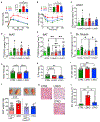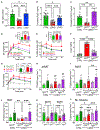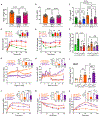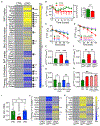FoxO1 suppresses Fgf21 during hepatic insulin resistance to impair peripheral glucose utilization and acute cold tolerance
- PMID: 33761350
- PMCID: PMC8529953
- DOI: 10.1016/j.celrep.2021.108893
FoxO1 suppresses Fgf21 during hepatic insulin resistance to impair peripheral glucose utilization and acute cold tolerance
Abstract
Fgf21 (fibroblast growth factor 21) is a regulatory hepatokine that, in pharmacologic form, powerfully promotes weight loss and glucose homeostasis. Although "Fgf21 resistance" is inferred from higher plasma Fgf21 levels in insulin-resistant mice and humans, diminished Fgf21 function is understood primarily via Fgf21 knockout mice. By contrast, we show that modestly reduced Fgf21-owing to cell-autonomous suppression by hepatic FoxO1-contributes to dysregulated metabolism in LDKO mice (Irs1L/L⋅Irs2L/L⋅CreAlb), a model of severe hepatic insulin resistance caused by deletion of hepatic Irs1 (insulin receptor substrate 1) and Irs2. Knockout of hepatic Foxo1 in LDKO mice or direct restoration of Fgf21 by adenoviral infection restored glucose utilization by BAT (brown adipose tissue) and skeletal muscle, normalized thermogenic gene expression in LDKO BAT, and corrected acute cold intolerance of LDKO mice. These studies highlight the Fgf21-dependent plasticity and importance of BAT function to metabolic health during hepatic insulin resistance.
Keywords: FGF21; FoxO1; brown adipose tissue; cold intolerance; glucose disposal; hepatic insulin resistance; hepatokine; insulin receptor substrate; peripheral insulin resistance.
Copyright © 2021 The Author(s). Published by Elsevier Inc. All rights reserved.
Conflict of interest statement
Declaration of interests M.F.W. is an advisory board member of Housey Pharma (https://www.housey.com/).
Figures





Similar articles
-
Acute Deletion of the FOXO1-dependent Hepatokine FGF21 Does not Alter Basal Glucose Homeostasis or Lipolysis in Mice.Endocrinology. 2022 May 1;163(5):bqac035. doi: 10.1210/endocr/bqac035. Endocrinology. 2022. PMID: 35303074 Free PMC article.
-
Hepatic follistatin increases basal metabolic rate and attenuates diet-induced obesity during hepatic insulin resistance.Mol Metab. 2023 May;71:101703. doi: 10.1016/j.molmet.2023.101703. Epub 2023 Mar 10. Mol Metab. 2023. PMID: 36906067 Free PMC article.
-
Inactivating hepatic follistatin alleviates hyperglycemia.Nat Med. 2018 Jul;24(7):1058-1069. doi: 10.1038/s41591-018-0048-0. Epub 2018 Jun 4. Nat Med. 2018. PMID: 29867232 Free PMC article.
-
FGF21: A Novel Regulator of Glucose and Lipid Metabolism and Whole-Body Energy Balance.Horm Metab Res. 2022 Apr;54(4):203-211. doi: 10.1055/a-1778-4159. Epub 2022 Apr 12. Horm Metab Res. 2022. PMID: 35413740 Review.
-
Adapting to the Cold: A Role for Endogenous Fibroblast Growth Factor 21 in Thermoregulation?Front Endocrinol (Lausanne). 2020 Jul 2;11:389. doi: 10.3389/fendo.2020.00389. eCollection 2020. Front Endocrinol (Lausanne). 2020. PMID: 32714278 Free PMC article. Review.
Cited by
-
Fibroblast growth factor 21 resistance is associated with body shape in patients with type 2 diabetes complicating hypertension.Front Cardiovasc Med. 2023 Jun 22;10:1168047. doi: 10.3389/fcvm.2023.1168047. eCollection 2023. Front Cardiovasc Med. 2023. PMID: 37424900 Free PMC article.
-
Fibroblast Growth Factor 21: A Fascinating Perspective on the Regulation of Muscle Metabolism.Int J Mol Sci. 2023 Nov 29;24(23):16951. doi: 10.3390/ijms242316951. Int J Mol Sci. 2023. PMID: 38069273 Free PMC article. Review.
-
The role of hepatokines in NAFLD.Cell Metab. 2023 Feb 7;35(2):236-252. doi: 10.1016/j.cmet.2023.01.006. Cell Metab. 2023. PMID: 36754018 Free PMC article. Review.
-
Cold-induced FOXO1 nuclear transport aids cold survival and tissue storage.Nat Commun. 2024 Apr 3;15(1):2859. doi: 10.1038/s41467-024-47095-w. Nat Commun. 2024. PMID: 38570500 Free PMC article.
-
Hepatic p38α MAPK controls gluconeogenesis via FOXO1 phosphorylation at S273 during glucagon signalling in mice.Diabetologia. 2023 Jul;66(7):1322-1339. doi: 10.1007/s00125-023-05916-5. Epub 2023 May 19. Diabetologia. 2023. PMID: 37202506
References
-
- Assini JM, Mulvihill EE, Burke AC, Sutherland BG, Telford DE, Chhoker SS, Sawyez CG, Drangova M, Adams AC, Kharitonenkov A, et al. (2015). Naringenin prevents obesity, hepatic steatosis, and glucose intolerance in male mice independent of fibroblast growth factor 21. Endocrinology 156, 2087–2102. - PubMed
-
- Badman MK, Pissios P, Kennedy AR, Koukos G, Flier JS, and Maratos-Flier E (2007). Hepatic fibroblast growth factor 21 is regulated by PPARalpha and is a key mediator of hepatic lipid metabolism in ketotic states. Cell Metab. 5, 426–437. - PubMed
Publication types
MeSH terms
Substances
Grants and funding
LinkOut - more resources
Full Text Sources
Other Literature Sources
Medical
Molecular Biology Databases
Research Materials
Miscellaneous

